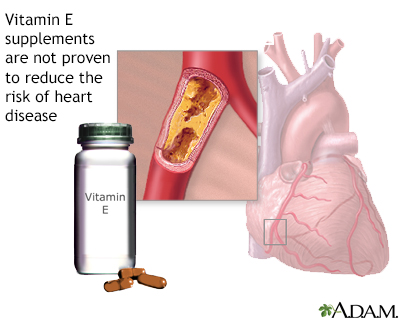Vitamin E
Alpha-tocopherol; Gamma-tocopherol
Vitamin E is a fat-soluble vitamin. Your body stores vitamin E in fatty tissue and the liver.
Images



I Would Like to Learn About:
Function
Vitamin E has the following functions:
- It is an antioxidant. This means it protects body tissue from damage caused by substances called free radicals. Free radicals can harm cells, tissues, and organs. They are believed to play a role in certain conditions related to aging.
- It helps keep the immune system strong against viruses and bacteria.
- It helps form red blood cells and widen blood vessels to keep blood from clotting inside them.
- It helps the body use vitamin K.
- Cells also use vitamin E to interact with each other. It helps them carry out many important functions.
Determining whether vitamin E can prevent cancer, heart disease, dementia, liver disease, and stroke requires further research.
Food Sources
The best way to get the daily requirement of vitamin E is by eating food sources. Vitamin E is found in the following foods:
- Vegetable oils (such as wheat germ, sunflower, safflower, corn, and soybean oils)
- Nuts (such as almonds, peanuts, and hazelnuts/filberts)
- Seeds (such as sunflower seeds)
- Green leafy vegetables (such as spinach and broccoli)
- Fortified breakfast cereals, fruit juices, margarine, and spreads.
Fortified means that vitamins have been added to the food. Check the Nutrition Fact Panel on the food label.
Products made from these foods, such as margarine, also contain vitamin E.
Side Effects
Eating vitamin E in foods is not risky or harmful. However, high doses of vitamin E supplements (alpha-tocopherol supplements) might increase the risk of bleeding in the brain (hemorrhagic stroke).
High levels of vitamin E may also increase the risk for birth defects. However, this needs more research.
Low intake may lead to hemolytic anemia in premature babies.
Recommendations
Recommendations for vitamin E, as well as other nutrients, are provided in the Dietary Reference Intakes (DRIs) developed by the Food and Nutrition Board at the National Academies of Sciences, Engineering, and Medicine. DRI is a term for a set of reference intakes that are used to plan and assess the nutrient intakes of healthy people. These values, which vary by age and sex, include:
Recommended Dietary Allowance (RDA): The average daily level of intake that is enough to meet the nutrient needs of nearly all (97% to 98%) healthy people. An RDA is an intake level based on scientific research evidence.
Adequate Intake (AI): This level is established when there is not enough scientific research evidence to develop an RDA. It is set at a level that is thought to ensure enough nutrition.
Dietary reference intakes for vitamin E:
Infants (AI)
- 0 to 6 months: 4 milligrams per day (mg/day)
- 7 to 12 months: 5 mg/day
Children (RDA)
- 1 to 3 years: 6 mg/day
- 4 to 8 years: 7 mg/day
- 9 to 13 years: 11 mg/day
Adolescents and adults (RDA)
- 14 and older: 15 mg/day
- Pregnant teens and women: 15 mg/day
- Breastfeeding teens and women: 19 mg/day
Ask your health care provider which amount is best for you.
The highest safe level of vitamin E supplements for adults is 1000 mg/day (equal to 1,500 IU/day for natural forms of vitamin E, and 1,100 IU/day for the man-made or synthetic form).
Related Information
Vitamin KReferences
Markell M, Siddiqi HA. Vitamins and trace elements. In: McPherson RA, Pincus MR, eds. Henry's Clinical Diagnosis and Management by Laboratory Methods. 24th ed. Philadelphia, PA: Elsevier; 2022:chap 27.
Mason JB, Booth SL. Vitamins, trace minerals, and other micronutrients. In: Goldman L, Schafer AI, eds. Goldman-Cecil Medicine. 26th ed. Philadelphia, PA: Elsevier; 2020:chap 205.
National Institutes of Health website. Vitamin E: fact sheet for health professionals. ods.od.nih.gov/factsheets/VitaminE-HealthProfessional/. Updated March 26, 2021. Accessed February 8, 2023.
BACK TO TOPReview Date: 1/19/2023
Reviewed By: Stefania Manetti, RD/N, CDCES, RYT200, My Vita Sana LLC - Nourish and heal through food, San Jose, CA. Review provided by VeriMed Healthcare Network. Also reviewed by David C. Dugdale, MD, Medical Director, Brenda Conaway, Editorial Director, and the A.D.A.M. Editorial team.

Health Content Provider
06/01/2025
|
A.D.A.M., Inc. is accredited by URAC, for Health Content Provider (www.urac.org). URAC's accreditation program is an independent audit to verify that A.D.A.M. follows rigorous standards of quality and accountability. A.D.A.M. is among the first to achieve this important distinction for online health information and services. Learn more about A.D.A.M.'s editorial policy, editorial process and privacy policy. A.D.A.M. is also a founding member of Hi-Ethics. This site complied with the HONcode standard for trustworthy health information from 1995 to 2022, after which HON (Health On the Net, a not-for-profit organization that promoted transparent and reliable health information online) was discontinued. |
The information provided herein should not be used during any medical emergency or for the diagnosis or treatment of any medical condition. A licensed medical professional should be consulted for diagnosis and treatment of any and all medical conditions. Links to other sites are provided for information only -- they do not constitute endorsements of those other sites. © 1997- 2024 A.D.A.M., a business unit of Ebix, Inc. Any duplication or distribution of the information contained herein is strictly prohibited.
